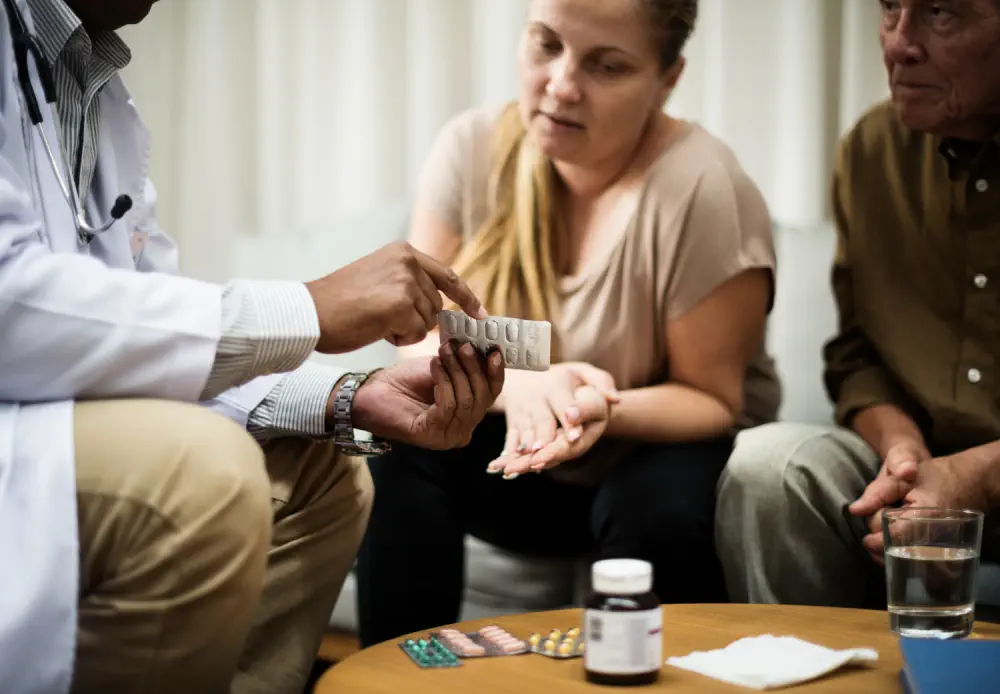We offer medical detox and multiple addiction treatment options in our
luxury treatment centres in Port Hope, Cobourg, and Ottawa.
How Harm Reduction Helps People Who Use Drugs
Naloxone kits. Clean needles. Supervised consumption sites. These tools now shape Canadian addiction care beyond traditional abstinence-only models. Harm reduction focuses on keeping people safer today while they still use substances. Health Canada reports over 27,000 overdose reversals from community-distributed naloxone kits since 2016. The evidence backs the approach - people stay alive, diseases spread less, and many eventually find paths to treatment when ready. For those struggling with substances, this approach creates an entry point to healthcare without demanding immediate sobriety first.
Key Takeaways
- Focus on Immediate Safety: Harm reduction aims to keep drug users safer right now. It recognizes that drug use is complex and that stopping completely isn't always the first or only goal. The approach emphasizes respect for people and helping them in their current situation.
- Programs Work to Save Lives and Prevent Disease: Services like supervised consumption sites, needle exchanges, and naloxone distribution are proven to prevent overdoses and slow the spread of diseases. They also help people connect with needed healthcare and social support.
- Treatment Is Adapting: Many treatment facilities now use harm reduction ideas. This means more flexible goals for people and fewer obstacles to getting help. These methods keep people engaged, even if they aren't ready to stop using substances entirely.
- Benefits Extend Beyond Individuals: Harm reduction helps communities too. It can cut healthcare costs, improve public safety by reducing public drug use and discarded needles, and support families.
- Challenges Remain, Despite Proof: Even with strong evidence, harm reduction often faces pushback and misunderstandings. Continued education and showing positive results are important for these programs to gain broader acceptance and support.

What Is Harm Reduction?
What is harm reduction? This practical approach starts with recognizing that many people will use drugs regardless of potential consequences. Instead of demanding immediate abstinence, this strategy focuses on minimizing negative health outcomes and supporting positive life changes, however small.
Drug use exists on a spectrum, and any step toward safer practices counts as success. Someone might not stop using methamphetamine today but might accept clean supplies, get tested for infectious diseases, or learn overdose prevention skills. These incremental improvements save lives and open doors to further positive changes.
Harm reduction began gaining prominence during the HIV/AIDS epidemic when needle exchange programs emerged to prevent disease transmission among people who injected drugs. Since then, the approach has expanded across public health initiatives, community programs, and clinical settings.
The core values include pragmatism, respecting human dignity, meeting people without judgment, and recognizing that people who use drugs deserve compassion and care like anyone else with health challenges.
Practical Applications of Harm Reduction Programs
Successful harm reduction programs come in various forms, each addressing different aspects of substance-related risks:
Supervised Consumption Services
These designated spaces allow people to use pre-obtained substances under healthcare supervision, preventing fatal overdoses. Vancouver's Insite facility documented a 35% decrease in overdose deaths in surrounding blocks following its implementation.
Beyond preventing immediate deaths, these sites connect people to crucial resources. Staff develop trust with participants, eventually helping many access healthcare, housing support, and treatment when they're ready.

Needle/Syringe Programs
These services distribute clean injection equipment, collect used supplies, and offer additional support. Research consistently shows they don't increase drug use but substantially reduce HIV and hepatitis C transmission. A major analysis of multiple studies found these programs reduced risky injection behaviours by 60%.
Sarah, who runs a mobile exchange unit in rural British Columbia, explains: "We hand out approximately 5,000 clean needles weekly, but we're doing much more. We provide naloxone kits, wound care, HIV/HCV testing, and connect people to healthcare who haven't seen a doctor in years."
Opioid Agonist Therapy
Medications like methadone and buprenorphine help people with opioid use disorders stabilize by preventing withdrawal symptoms and reducing cravings. Though sometimes mischaracterized as "substituting one drug for another," these medications allow people to regain stability, maintain jobs, rebuild relationships, and avoid illegal activities to obtain drugs.
The evidence strongly supports their effectiveness - patients receiving these medications show 50-75% lower mortality rates compared to those trying abstinence-only approaches.
Overdose Prevention and Response
With fentanyl contaminating much of the drug supply, overdose prevention education has become increasingly vital. Programs distribute naloxone alongside training on recognizing and responding to overdoses. Health Canada data shows thousands of overdose reversals through community-based initiatives, with numbers rising as distribution expands.
Harm Reduction Strategies in Treatment Settings
While often associated with street-level services, harm reduction strategies have transformed many formal treatment settings as well:
Flexible Treatment Goals
Rather than expelling clients who relapse, harm-centred facilities accept that substance use occurs on a spectrum. Progress might mean using less frequently, switching to less dangerous substances, or changing consumption methods to reduce health risks.
Brighter Path Recovery Center exemplifies this flexible approach. Clinical director Alex Morgan explains: "We celebrate abstinence, but also recognize when someone switches from injecting heroin to taking prescribed methadone, starts using clean needles, or simply attends therapy regularly despite ongoing substance use."
Low-Barrier Access to Care
Traditional treatment often requires navigating complicated systems while in crisis, making calls, securing insurance approval, completing assessments, and proving "readiness" for help. Our programs minimize these obstacles, offering immediate assistance without extensive prerequisites.
Prairie Health operates a walk-in clinic where people access care without appointments, insurance verification, or sobriety requirements. Staff address immediate needs first, then gradually introduce additional services as relationships develop.
Housing First Approaches
This model provides stable housing without requiring sobriety or treatment compliance. Research consistently shows people address substance use more effectively once basic needs for shelter and safety are met. A comprehensive study of Housing First programs across five Canadian cities found participants maintained housing stability while reducing emergency service use by over 50%.

Training Staff in Harm Reduction Principles
Implementing this approach requires specific skills. Harm reduction training typically covers several essential areas:
Anti-Stigma Education
Staff learn to recognize how personal biases affect care and practice respectful engagement with people who use drugs. This includes using person-first language (saying "person who uses drugs" rather than stigmatizing labels) and avoiding moral judgments about substance use.
Trainer Miguel Rodriguez emphasizes: "We teach providers to question assumptions. If someone misses appointments, instead of labelling them 'non-compliant,' we ask if the appointment time fits their life circumstances or if they face transportation challenges."
Trauma-Informed Care
Many people who use drugs have experienced significant trauma. Staff learn to create environments that promote safety and trust rather than replicating controlling dynamics that may echo past traumatic experiences.
Motivational Interviewing
This collaborative communication approach strengthens a person's motivation for positive change without confrontation. Practitioners learn to elicit and amplify the person's own reasons for changing rather than imposing external standards.
Psychologist Jamie Chen describes the shift: "We train counsellors to put away their expert hat and truly listen. When someone says they want to keep using meth but also want to see their kids more, we focus on their desire for family connection rather than arguing about the drug use. That desire becomes the foundation for positive change."
How Harm Reduction Programs Minimize Harm Beyond Individual Health
While improving individual health remains central, efforts to minimize harm extend to community and societal benefits:
Cost Savings
Untreated substance use disorders generate massive costs through emergency department visits, hospitalizations, incarceration, and productivity losses. Harm reduction interventions substantially reduce these expenses.
A cost-benefit analysis of syringe exchange programs found that every dollar invested saves at least three dollars in avoided HIV treatment costs alone. When including other prevented infections, emergency services, and criminal justice expenses, the savings multiply significantly.
Community Safety Improvements
Despite fears that harm reduction encourages problematic behaviour, these approaches often enhance public safety. Supervised consumption sites reduce public drug use and improperly discarded syringes in neighbourhoods. Mobile outreach programs actively collect used injection equipment from public spaces.
By building trust with marginalized populations, workers often facilitate conflict resolution and connect people to resources that reduce theft and other survival crimes.
Family Preservation
When people who use drugs receive support without judgment, they more successfully maintain family connections. Programs helping participants develop safer use practices often see improved parenting capacity and family stability.The Family Support Program at Parkdale Health specifically works with parents who use drugs, focusing on safer use practices, parenting skills, and meeting child welfare requirements. Their participating families achieve reunification at rates 60% higher than standard interventions.

Harm Prevention Across Multiple Domains
Complete harm prevention addresses risks beyond overdose and disease transmission:
Addressing Social Isolation
Stigma pushes people who use drugs into isolation, removing protective social connections. Community-based harm reduction spaces counter this by fostering belonging and mutual support.
The Open Door drop-in center functions as more than a service provider; it's a community hub where people share meals, celebrate milestones, and build supportive relationships. Program coordinator Lisa Wong notes, "Many participants describe this as the only place they don't have to hide who they are."
Violence Reduction
People who use drugs—especially women and gender-diverse individuals—face heightened risks of violence. Targeted programs help participants develop safety plans, access legal protection, and create peer support networks.
The Safe Steps Project collaborates with domestic violence organizations to train social workers in recognizing and responding to intimate partner violence. They've developed safety planning tools specifically addressing the unique challenges faced by people who use drugs.
Financial Stability Support
Economic insecurity both contributes to and results from problematic drug use. Progressive harm reduction programs incorporate income assistance navigation, vocational support, and benefits enrollment.
The Working Forward program offers same-day, low-barrier employment opportunities for cleaning city parks. Participants earn cash stipends while connecting to additional services, gaining references, and developing work history.
Challenges and Criticisms of Risk Reduction Approaches
Despite strong evidence supporting effectiveness, risk reduction approaches face persistent obstacles:
Political and Public Resistance
Many communities initially resist harm reduction services, fearing increased drug use or crime. Successful programs invest heavily in community engagement, sharing outcome data and building relationships with neighbourhood stakeholders.
After facing opposition to opening a syringe exchange, harm reduction coordinator Paul Jackson focused on education: "We invited community members to visit similar programs. Seeing people receiving compassionate care, rather than the chaotic scene they'd imagined, changed many minds."
Integration with Traditional Treatment
Abstinence-focused treatment systems sometimes struggle to incorporate new principles. Professional hierarchies, funding restrictions, and philosophical differences create barriers to integration.
Progress occurs when treatment centers recognize harm reduction as complementary to recovery, not opposed to it. Addiction psychiatrist Dr. Emma Liu notes, "People move through different stages in their relationship with substances. Harm reduction keeps them alive and connected during active use so they can eventually access recovery if they choose."
Funding Challenges
Many such programs operate on minimal budgets, relying on volunteers and short-term grants. Sustainable funding remains difficult, particularly for controversial interventions like supervised consumption.
Some organizations partner with healthcare institutions. The Prairie Harm Reduction Coalition collaborates with hospital systems that recognize how syringe services reduce costly infections. These hospitals now provide ongoing support alongside medical supplies and referral relationships.
FAQ
What is harm reduction, and how does it differ from abstinence-based approaches?
It's a set of practical strategies aimed at reducing the negative consequences of drug use without requiring abstinence. Unlike abstinence-only approaches that view success solely as stopping all drug use, harm reduction celebrates any positive change that reduces risk.
What types of programs are considered harm reduction?
Those programs include supervised consumption services, needle exchange programs, naloxone distribution, drug checking services, low-barrier housing, opioid agonist therapy, and overdose prevention education. Street outreach, drop-in centers, and peer support initiatives also frequently employ harm reduction principles.
Does harm reduction encourage drug use?
No. Research consistently shows that those strategies don't increase drug use rates. Instead, they connect people to health services they might otherwise avoid, ultimately leading many to reduce use or seek treatment. These approaches acknowledge that recovery paths vary and that keeping people alive and healthy creates opportunities for positive change.
How do harm reduction approaches minimize harm to communities?
Efforts to minimize harm extend beyond individual users. Programs reduce public injection, decrease discarded syringes, lower transmission of infectious diseases, reduce healthcare costs, decrease emergency service utilization, and often help address issues like poverty and homelessness that contribute to neighbourhood concerns.
What training do staff need to implement harm reduction effectively?
Harm reduction training typically includes education on stigma reduction, trauma-informed care, motivational interviewing, overdose prevention, cultural humility, and crisis de-escalation. Staff learn to create non-judgmental environments where people feel safe seeking help without fear of punishment or rejection.
How does harm prevention address needs beyond physical health?
Complete harm prevention addresses social isolation through community-building activities, reduces violence through safety planning and advocacy, supports financial stability through employment programs, and improves housing security. These approaches recognize that health involves more than just the absence of disease.






